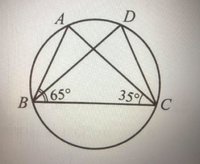You are using an out of date browser. It may not display this or other websites correctly.
You should upgrade or use an alternative browser.
You should upgrade or use an alternative browser.
How to find an angle?
- Thread starter marinaa11
- Start date
D
Deleted member 4993
Guest
Have you been taught any "circle" theorem? Particularly:Hi, I'm struggling with this task: find an angle D of the BDC triangle.
information given: the angle B (of triangle ABC) = 65 , the angle C (of triangle ACB) = 35.
My solution: I got that angle A is 80 (180-65-35), but don't know, that's next...
Thank you for help.
View attachment 22533
All angles inscribed in a circle and subtended by the same chord are equal. The inscribed angle is equal to one half of the central angle subtended by the chord.
pka
Elite Member
- Joined
- Jan 29, 2005
- Messages
- 11,976
Please note that \(\angle A~\&~\angle D\) both are inscribed angles and both intercept the arc \(\widehat{BC}\).Hi, I'm struggling with this task: find an angle D of the BDC triangle.
information given: the angle B (of triangle ABC) = 65 , the angle C (of triangle ACB) = 35.
My solution: I got that angle A is 80 (180-65-35), but don't know, that's next...
Thank you for help.
View attachment 22533
What does that tell us about their measures?
Does what mean that angle D is equal to angle C?Please note that \(\angle A~\&~\angle D\) both are inscribed angles and both intercept the arc \(\widehat{BC}\).
What does that tell us about their measures?
pka
Elite Member
- Joined
- Jan 29, 2005
- Messages
- 11,976
If you say that angle D equals angle C that means they are exactly the same angle!Does what mean that angle D is equal to angle C?
From the diagram they are clearly different angles.
Do you mean that they have the same measure? The answer is not necessarily.
It does mean \(m(\angle A)=m(\angle D)=80^{ \circ}\).
Finally, I understood! Thanks a lotIf you say that angle D equals angle C that means they are exactly the same angle!
From the diagram they are clearly different angles.
Do you mean that they have the same measure? The answer is not necessarily.
It does mean \(m(\angle A)=m(\angle D)=80^{ \circ}\).

